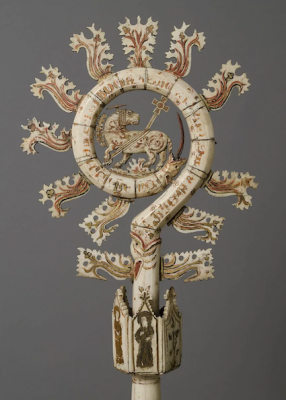Gospel in Art: Take nothing for the journey except a staff

Crozier with Lamb of God, Northern Italian, made in possibly the Lagoon district of Venice, Italian, 1360-1400, © Metropolitan Museum, New York
Source: Christian Art
Gospel of 1 February 2024
Mark 6:7-13
Jesus made a tour round the villages, teaching. Then he summoned the Twelve and began to send them out in pairs giving them authority over the unclean spirits. And he instructed them to take nothing for the journey except a staff - no bread, no haversack, no coppers for their purses. They were to wear sandals but, he added, 'Do not take a spare tunic.' And he said to them, 'If you enter a house anywhere, stay there until you leave the district. And if any place does not welcome you and people refuse to listen to you, as you walk away shake off the dust from under your feet as a sign to them.' So they set off to preach repentance; and they cast out many devils, and anointed many sick people with oil and cured them.
Reflection on the Crozier
In our Gospel reading today, the disciples are being instructed to take only a staff for their journey. Jesus was emphasising the importance of simplicity and reliance on God's provision during their mission. He wanted them to trust in God's guidance and power rather than relying on their own resources or possessions.
Staffs are mentioned throughout the Old Testament. They are associated not only with providing support for a walking journey, but also with shepherding. Shepherds used their staffs to guide and protect their flocks. The image of God as a shepherd is a recurring theme, and the staff symbolises God's guidance and care for his people. See Psalm 23:4 for example, "Your rod and your staff, they comfort me." Think also of Moses and his staff, Aaron's Blossoming Staff, Jacob's staff when crossing the river Jordan, etc... So Jesus told his disciples to take their staffs in order to provide support for their walking journeys, but also as symbols of them being guides and protectors.
This is certainly the context for bishops having a crozier, also known as a pastoral staff. The use of the crozier by bishops symbolises their role as shepherds of the faithful, echoing the biblical imagery of Jesus as the Good Shepherd, and journeying alongside the disciples showing the way forward. The crozier is a visual reminder of the bishop's role as a successor to the apostles and a leader of the local Christian community.
Our crozier is North Italian, probably made in the region of Venice. This crozier was originally made in sections with threaded ends. The Lamb of God is set within a circular reserve, further set with sections painted with emanating flames.
LINKS
Gospel in Art: https://christian.art/
Today's Reflection: https://christian.art/daily-gospel-reading/mark-6-7-13-2024/


















